ECU GMC YUKON XL DENALI 2001 Owners Manual
[x] Cancel search | Manufacturer: GMC, Model Year: 2001, Model line: YUKON XL DENALI, Model: GMC YUKON XL DENALI 2001Pages: 394, PDF Size: 2.77 MB
Page 22 of 394

1-9
Returning the Seats to an Upright Position
To return the seat to the upright position, do
the following:
1. Lift the seatback up and push it rearward all the way.
2. Lower the seat cushion until it latches into position.
3. On Denali XL models, lift the load floor panels and
latch them into the seatback.
4. Pull forward on the seatback and up on the seat
cushion to make sure the seat is securely in place.
5. Return the head restraints to the upright position.
6. Check to see that the safety belt buckles on the
driver's side seatback are accessible to the outboard
and center occupants and are not under the
seat cushions.Bucket Seats (Second Row)
If your vehicle has bucket seats, the seatbacks can be
reclined and and the seats can be folded to give you
more cargo room.
Reclining the Bucket Seats
To recline the seatback, do the following:
1. Pull the lever located at
the base of the seat
cushion forward.
2. Release the lever to lock the seatback where
you want it. Pull the lever again without pushing
on the seatback and the seatback will go to an
upright position.
Page 24 of 394

1-11
Once the seatbacks are folded down, the rear seat
footwell area will be exposed and will have to be
covered by the load floor panel. To create a load floor,
do the following:
1. Release the panels from the seatbacks by pushing
forward on the latches.
2. Then fold the panels back to cover the rear seat
footwell area.Returning the Seats to an Upright Position
To return the seat to the upright position, do
the following:
1. Lift the seatback up and push it rearward all the way.
2. Lower the seat cushion until it latches into position.
3. Lift the load floor panels and latch them into
the seatback.
4. Pull forward on the seatback and up on the seat
cushion to make sure the seat is securely in place.
5. Return the head restraints to the upright position.
Page 29 of 394
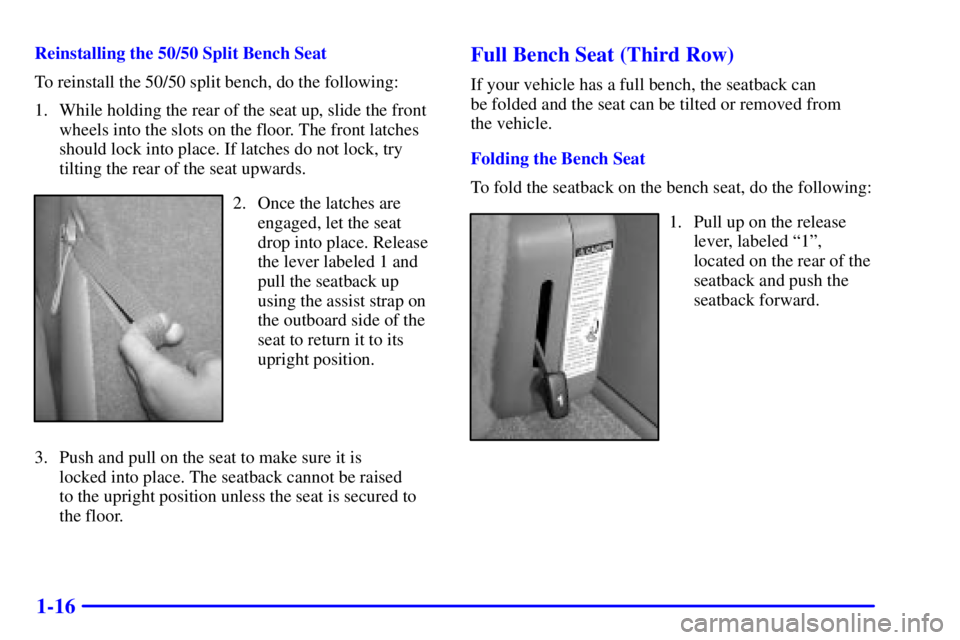
1-16
Reinstalling the 50/50 Split Bench Seat
To reinstall the 50/50 split bench, do the following:
1. While holding the rear of the seat up, slide the front
wheels into the slots on the floor. The front latches
should lock into place. If latches do not lock, try
tilting the rear of the seat upwards.
2. Once the latches are
engaged, let the seat
drop into place. Release
the lever labeled 1 and
pull the seatback up
using the assist strap on
the outboard side of the
seat to return it to its
upright position.
3. Push and pull on the seat to make sure it is
locked into place. The seatback cannot be raised
to the upright position unless the seat is secured to
the floor.
Full Bench Seat (Third Row)
If your vehicle has a full bench, the seatback can
be folded and the seat can be tilted or removed from
the vehicle.
Folding the Bench Seat
To fold the seatback on the bench seat, do the following:
1. Pull up on the release
lever, labeled ª1º,
located on the rear of the
seatback and push the
seatback forward.
Page 34 of 394
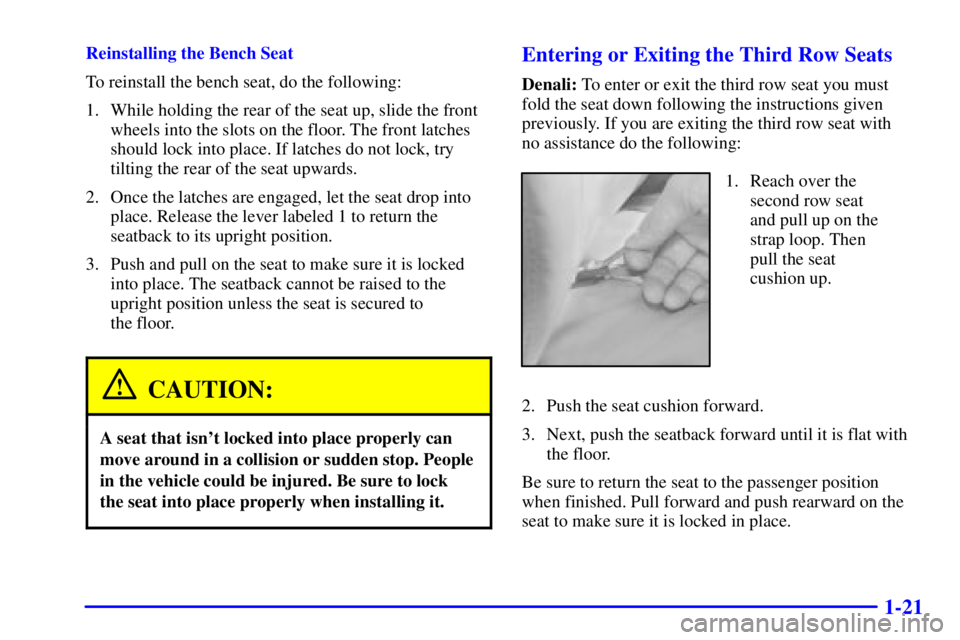
1-21
Reinstalling the Bench Seat
To reinstall the bench seat, do the following:
1. While holding the rear of the seat up, slide the front
wheels into the slots on the floor. The front latches
should lock into place. If latches do not lock, try
tilting the rear of the seat upwards.
2. Once the latches are engaged, let the seat drop into
place. Release the lever labeled 1 to return the
seatback to its upright position.
3. Push and pull on the seat to make sure it is locked
into place. The seatback cannot be raised to the
upright position unless the seat is secured to
the floor.
CAUTION:
A seat that isn't locked into place properly can
move around in a collision or sudden stop. People
in the vehicle could be injured. Be sure to lock
the seat into place properly when installing it.
Entering or Exiting the Third Row Seats
Denali: To enter or exit the third row seat you must
fold the seat down following the instructions given
previously. If you are exiting the third row seat with
no assistance do the following:
1. Reach over the
second row seat
and pull up on the
strap loop. Then
pull the seat
cushion up.
2. Push the seat cushion forward.
3. Next, push the seatback forward until it is flat with
the floor.
Be sure to return the seat to the passenger position
when finished. Pull forward and push rearward on the
seat to make sure it is locked in place.
Page 42 of 394
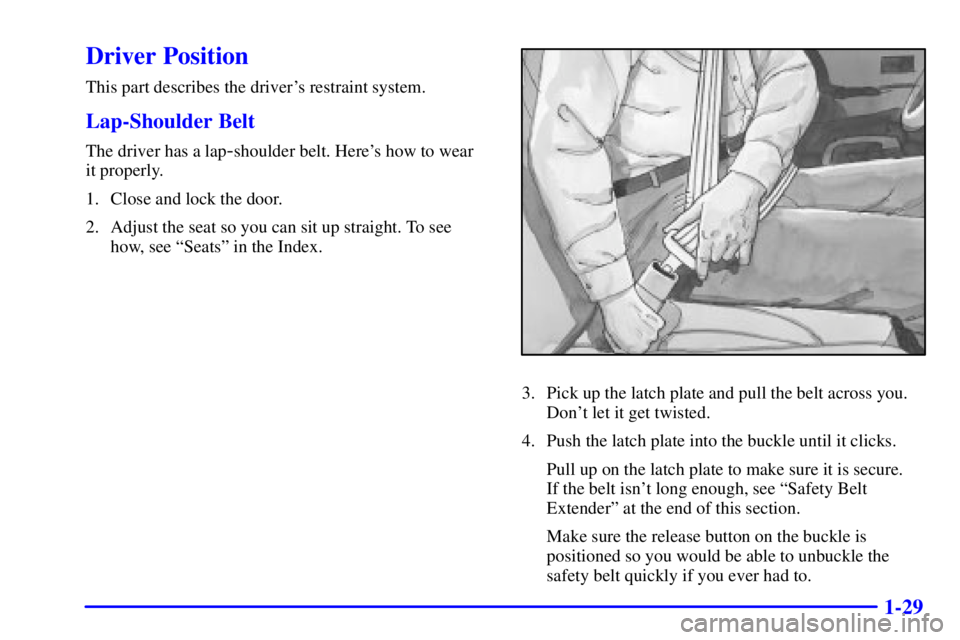
1-29
Driver Position
This part describes the driver's restraint system.
Lap-Shoulder Belt
The driver has a lap-shoulder belt. Here's how to wear
it properly.
1. Close and lock the door.
2. Adjust the seat so you can sit up straight. To see
how, see ªSeatsº in the Index.
3. Pick up the latch plate and pull the belt across you.
Don't let it get twisted.
4. Push the latch plate into the buckle until it clicks.
Pull up on the latch plate to make sure it is secure.
If the belt isn't long enough, see ªSafety Belt
Extenderº at the end of this section.
Make sure the release button on the buckle is
positioned so you would be able to unbuckle the
safety belt quickly if you ever had to.
Page 51 of 394
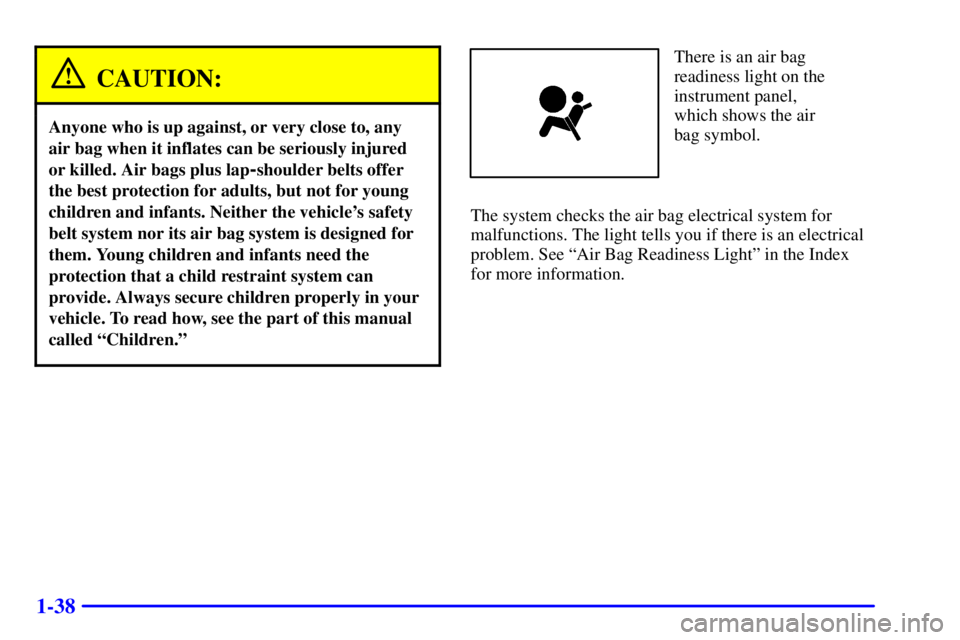
1-38
CAUTION:
Anyone who is up against, or very close to, any
air bag when it inflates can be seriously injured
or killed. Air bags plus lap
-shoulder belts offer
the best protection for adults, but not for young
children and infants. Neither the vehicle's safety
belt system nor its air bag system is designed for
them. Young children and infants need the
protection that a child restraint system can
provide. Always secure children properly in your
vehicle. To read how, see the part of this manual
called ªChildren.º
There is an air bag
readiness light on the
instrument panel,
which shows the air
bag symbol.
The system checks the air bag electrical system for
malfunctions. The light tells you if there is an electrical
problem. See ªAir Bag Readiness Lightº in the Index
for more information.
Page 59 of 394
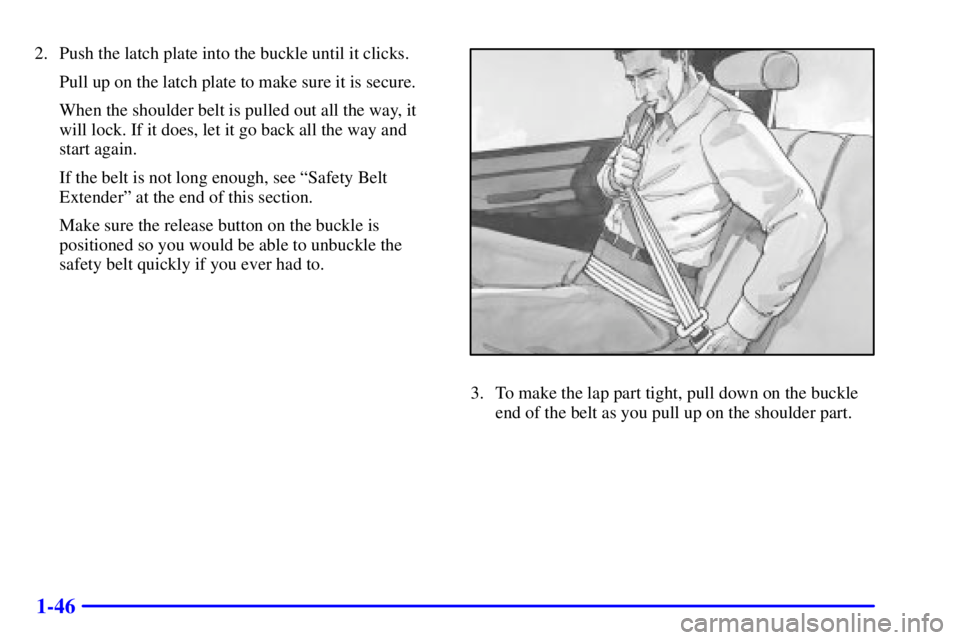
1-46
2. Push the latch plate into the buckle until it clicks.
Pull up on the latch plate to make sure it is secure.
When the shoulder belt is pulled out all the way, it
will lock. If it does, let it go back all the way and
start again.
If the belt is not long enough, see ªSafety Belt
Extenderº at the end of this section.
Make sure the release button on the buckle is
positioned so you would be able to unbuckle the
safety belt quickly if you ever had to.
3. To make the lap part tight, pull down on the buckle
end of the belt as you pull up on the shoulder part.
Page 67 of 394
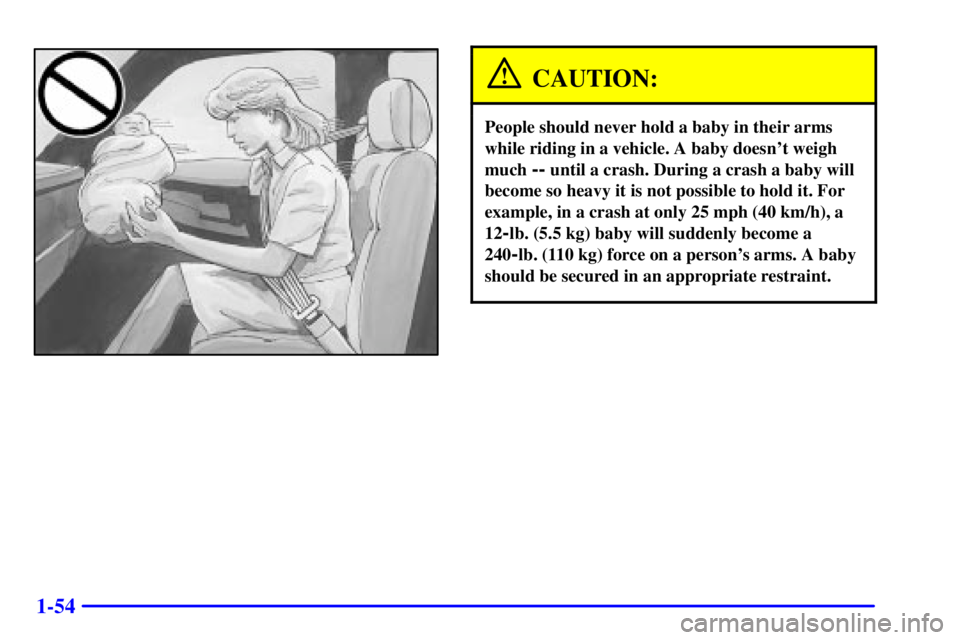
1-54
CAUTION:
People should never hold a baby in their arms
while riding in a vehicle. A baby doesn't weigh
much
-- until a crash. During a crash a baby will
become so heavy it is not possible to hold it. For
example, in a crash at only 25 mph (40 km/h), a
12
-lb. (5.5 kg) baby will suddenly become a
240
-lb. (110 kg) force on a person's arms. A baby
should be secured in an appropriate restraint.
Page 69 of 394

1-56
Q:What are the different types of add-on
child restraints?
A:Add-on child restraints, which are purchased by the
vehicle's owner, are available in four basic types.
Selection of a particular restraint should take into
consideration not only the child's weight, height
and age but also whether or not the restraint will be
compatible with the motor vehicle in which it will
be used.
For most basic types of child restraints, there are
many different models available. When purchasing
a child restraint, be sure it is designed to be used
in a motor vehicle. If it is, the restraint will have a
label saying that it meets federal motor vehicle
safety standards.
The restraint manufacturer's instructions that
come with the restraint state the weight and height
limitations for a particular child restraint. In
addition, there are many kinds of restraints
available for children with special needs.
CAUTION:
Newborn infants need complete support,
including support for the head and neck. This
is necessary because a newborn infant's neck is
weak and its head weighs so much compared
with the rest of its body. In a crash, an infant in
a rear
-facing seat settles into the restraint, so
the crash forces can be distributed across the
strongest part of an infant's body, the back and
shoulders. Infants always should be secured in
appropriate infant restraints.
Page 70 of 394
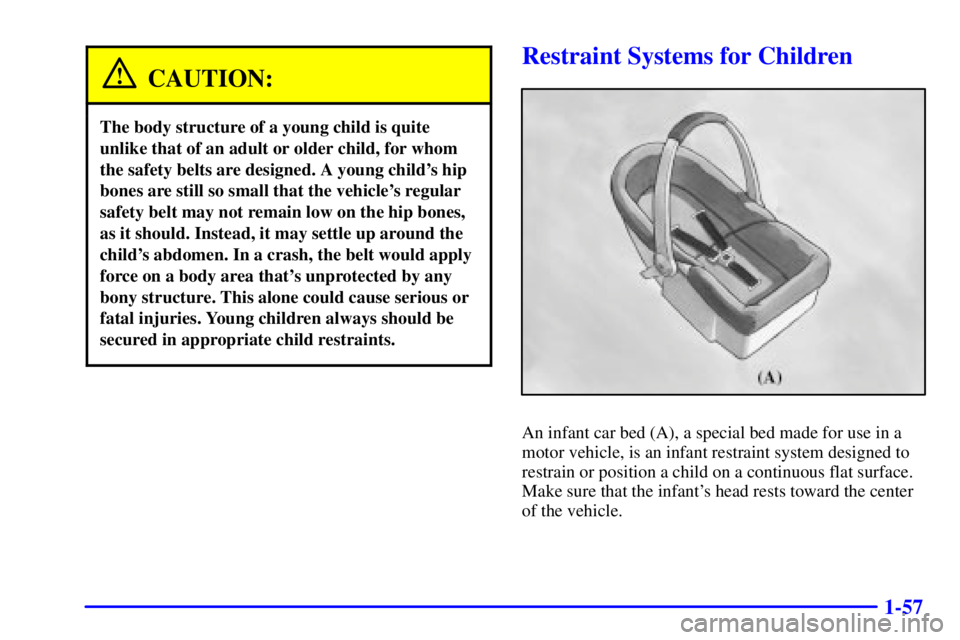
1-57
CAUTION:
The body structure of a young child is quite
unlike that of an adult or older child, for whom
the safety belts are designed. A young child's hip
bones are still so small that the vehicle's regular
safety belt may not remain low on the hip bones,
as it should. Instead, it may settle up around the
child's abdomen. In a crash, the belt would apply
force on a body area that's unprotected by any
bony structure. This alone could cause serious or
fatal injuries. Young children always should be
secured in appropriate child restraints.
Restraint Systems for Children
An infant car bed (A), a special bed made for use in a
motor vehicle, is an infant restraint system designed to
restrain or position a child on a continuous flat surface.
Make sure that the infant's head rests toward the center
of the vehicle.